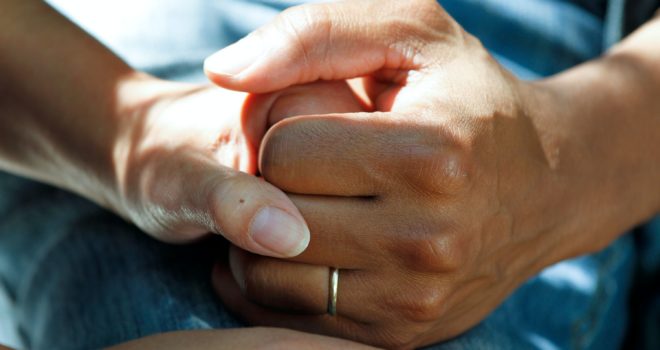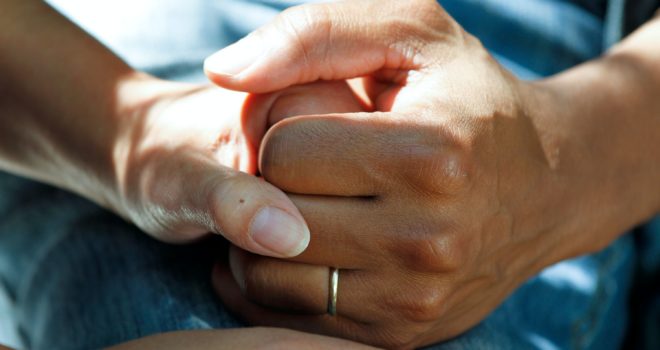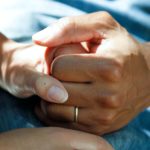I had brain surgery this week. Deep Brain Stimulation (DBS), to be precise. It i the last step of Treatment for Parkinson’s Disease and is only given after all medical (read drug) therapies have been tried and are no longer effective. As brain surgeries go, it is routine; over 150,000 Parkinson’s patients have had it to date. In concept it is similar to a heart’s pacemaker .
But it is still brain surgery, with finite risks of death and strokes, so part of my prep was to get Anointing of the Sick, the sacrament of the Catholic Church which is given to those in danger of death from sickness or old age to give the graces of strengthening, peace and courage to face what is ahead. The anointing is clearly pointing to the celestial kingdom, uniting our suffering to that of Christ while promising physical healing only if it is critical to the salvation of souls. It’s scary to contemplate that this is the last possible treatment for Parkinson’s and from here it is all downhill in addition to the reality that I was allowing a doctor to drill holes into my head, so the graces present in the sacrament were appropriate and desired.
DBS is typically done in two stages. In the first stage, the task is to embed the electrodes into the brain. It takes 5-6 hours and is by far the most delicate and scary part of the surgery. It is also highly interactive, depending on the patient to accurately articulate what they can see and hear and feel during the critical placement of the electrodes into the brain. For instance, I felt that they were suppressing my heartbeat with one placement. Which they immediately corrected. They sent me to a neuropsychologist for extensive (4 hours) testing of my mental acuity a week before the procedure to establish a baseline and to ensure that I was not suffering from depression or dementia and could give them responses that they were sure were accurate.
The set up for the first stage is interesting. They put me out in order to shave my head and screw a steel frame to it. Then they woke me up and from then on I felt like part of the surgical team, although I was unvested a little more than the rest of them. It was a strange feeling when they told me it was going to be loud while the drilled the nickel-sized holes in my skull. I was just hoping they stopped in time to not hit the actual brain. The doctor had predetermined, with an MRI, target locations for the electrodes. They then adjusted the final placement of the electrodes through their interaction with me. They knew by my responses whether they were in the optimum place or not. Sometimes by judging my ability to follow a finger, sometimes by checking my ability to count the fingers they held up, sometimes by repeating phrases they said. Ironically, they correct based on errors so if you would have made these errors any way, you provide false information. The more mentally capable and alert you are, the better your results are likely to be.
The second stage is done on an outpatient basis under general anesthesia. It only took the doctor about an hour to place the neuropulse generator under my collarbone and feed wires under my skin. to attach to the leads. They will wait two weeks for the brain to heal and then they will take out the stitches and staples that are arranged like two train tracks running parallel across my shaved scalp, and program the system, when I will see the result of my gamble. The surgical team was confident and very complementary about the quality of my responses in the first stage of the surgery and so they felt I would be very pleased with the quality of life the treatment offers for 5 years or more.
The gamble was whether to pull the trigger on the last resort for enhanced quality of life with Parkinson’s and whether to do it before completing a series of events that are important for me and my family, knowing that there was a small but real chance that I would not survive the surgery. These events included hosting my children at home for Thanksgiving, then going on a cruise in Australia and New Zealand with my wife over Christmas and New Year’s. I would get back just in time to teach nursing ethics in the spring semester at the Catholic University of America. A couple of days after the final exams, my son Dan will marry his college sweetheart Carly Bibber, which will be a joyous family event. As it turns out, it was the right choice because now I likely will be able to enjoy these things with better health. Further, I will be able to support the sequel to my book Why All People Suffer, Dying Without Fear, which Sophia Institute Press is expected to release in June 2023. Writing these two books was unexpected but cathartic to do, as I contemplated my life journey and studied what the Church has to say about it. What I found out gave me solace in my suffering and the courage to face the real possibility of death without fear. My belief is that what I learned is truth and will benefit others so I am sharing it through these two books, which are grounded in Church teaching, my own experiences and those of immediate family members going back three generations.
✠
Photo by National Cancer Institute on Unsplash













